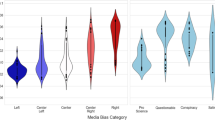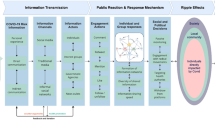Abstract
In our study, we investigate the persistence of misinformation in social networks, focusing on the longevity of discussions related to misinformation. We employ the CoVaxxy dataset, which encompasses COVID-19 vaccine-related tweets, and classify tweets as reliable/unreliable based on non-credible sources/accounts. We construct separate networks for retweets, replies, and mentions, applying centrality metrics (degree, betweenness, closeness) to assess tweet significance. Our objective is to determine how long tweets associated with non-credible sources remain active. Our findings reveal a noteworthy correlation: tweets with longer lifespans tend to be influential nodes within the network, while shorter-lived tweets have less impact. y shedding light on the longevity of misinformation within social networks, our research contributes to a better understanding of misinformation propagation dynamics. These insights can inform strategies to combat misinformation during public health crises like the COVID-19 pandemic.
Access this chapter
Tax calculation will be finalised at checkout
Purchases are for personal use only
Similar content being viewed by others
Notes
References
Ahvanooey, M.T., Zhu, M.X., Mazurczyk, W., Choo, K.K.R., Conti, M., Zhang, J.: Misinformation detection on social media: challenges and the road ahead. IT Professional 24(1), 34–40 (2022). https://doi.org/10.1109/MITP.2021.3120876
De Meo, P., Ferrara, E., Fiumara, G., Provetti, A.: Generalized louvain method for community detection in large networks. In: 2011 11th International Conference on Intelligent Systems Design and Applications, pp. 88–93 (2011). https://doi.org/10.1109/ISDA.2011.6121636
DeVerna, M.R., Aiyappa, R., Pacheco, D., Bryden, J., Menczer, F.: Identification and characterization of misinformation superspreaders on social media. CoRR abs/2207.09524 (2022). https://doi.org/10.48550/arXiv.2207.09524
DeVerna, M.R., et al.: Covaxxy: a collection of english-language twitter posts about covid-19 vaccines. In:Proceedings of the International AAAI Conference on Web and Social Media 15(1), 992–999 (2021). https://ojs.aaai.org/index.php/ICWSM/article/view/18122
Duzen, Z.: covaxxy-data-mining. https://github.com/duzenz/covaxxy-data-mining (2023). Accessed June 9 2023
Duzen, Z., Riveni, M., Aktas, M.: Processes for misinformation spread-analysis on social networks: a covid-19 case study. IEEE CPS Xplore (2023). Accepted for publication
Lazer, D.M.J., et al.: The science of fake news. Science 359(6380), 1094–1096 (2018). https://doi.org/10.1126/science.aao2998.https://www.science.org/doi/abs/10.1126/science.aao2998
Massey, P.M., Kearney, M.D., Hauer, M.K., Selvan, P., Koku, E., Leader, A.E.: Dimensions of misinformation about the hpv vaccine on instagram: Content and network analysis of social media characteristics. J. Med. Internet Res. 22(12), e21,451 (2020). https://doi.org/10.2196/21451., https://www.jmir.org/2020/12/e21451
Nakov, P., et al.: The clef-2021 checkthat! lab on detecting check-worthy claims, previously fact-checked claims, and fake news. In: Hiemstra, D., Moens, M.F., Mothe, J., Perego, R., Potthast, M., Sebastiani, F. (eds.) Advances in Information Retrieval, pp. 639–649. Springer International Publishing, Cham (2021)
Pastor-Escuredo, D., Tarazona, C.: Characterizing information leaders in twitter during COVID-19 crisis. CoRR abs/2005.07266 (2020)
Petratos, P.N.: Misinformation, disinformation, and fake news: Cyber risks to business. Business Horizons 64(6), 763–774 (2021). https://doi.org/10.1016/j.bushor.2021.07.012. https://www.sciencedirect.com/science/article/pii/S000768132100135X. CIBER SPECIAL ISSUE: CYBERSECURITY IN CRISIS
Ratkiewicz, J., Conover, M., Meiss, M., Goncalves, B., Flammini, A., Menczer, F.: Detecting and tracking political abuse in social media. Proc.e Int. AAAI Conf. Web Social Media 5(1), 297–304 (2021). https://doi.org/10.1609/icwsm.v5i1.14127.https://ojs.aaai.org/index.php/ICWSM/article/view/14127
Roitero, K., et al.: Can the crowd judge truthfulness? a longitudinal study on recent misinformation about COVID-19. Pers. Ubiquitous Comput. 27(1), 59–89 (2023). https://doi.org/10.1007/s00779-021-01604-6
Shrestha, A., Spezzano, F.: Online misinformation: from the deceiver to the victim. In: F. Spezzano, W. Chen, X. Xiao (eds.) ASONAM ’19: International Conference on Advances in Social Networks Analysis and Mining, Vancouver, British Columbia, Canada, 27-30 August, 2019, pp. 847–850. ACM (2019). https://doi.org/10.1145/3341161.3343536
Tambuscio, M., Ruffo, G., Flammini, A., Menczer, F.: Fact-checking effect on viral hoaxes: a model of misinformation spread in social networks. In: A. Gangemi, S. Leonardi, A. Panconesi (eds.) Proceedings of the 24th International Conference on World Wide Web Companion, WWW 2015, Florence, Italy, May 18-22, 2015 - Companion Volume, pp. 977–982. ACM (2015). https://doi.org/10.1145/2740908.2742572
Vo, N., Lee, K.: Learning from fact-checkers: analysis and generation of fact-checking language. In: Proceedings of the 42nd International ACM SIGIR Conference on Research and Development in Information Retrieval, SIGIR’19, p. 335–344. Association for Computing Machinery, New York, NY, USA (2019). https://doi.org/10.1145/3331184.3331248
Vogel, I., Meghana, M.: Detecting fake news spreaders on twitter from a multilingual perspective. In: 2020 IEEE 7th International Conference on Data Science and Advanced Analytics (DSAA), pp. 599–606. IEEE (2020)
Vosoughi, S., Roy, D., Aral, S.: The spread of true and false news online. Science 359(6380), 1146–1151 (2018). 10.1126/science.aap9559. https://www.science.org/doi/abs/10.1126/science.aap9559
Zafarani, R., Zhou, X., Shu, K., Liu, H.: Fake news research: Theories, detection strategies, and open problems. In: Proceedings of the 25th ACM SIGKDD International Conference on Knowledge Discovery & Data Mining, KDD ’19, pp. 3207–3208. Association for Computing Machinery, New York, NY, USA (2019). https://doi.org/10.1145/3292500.3332287
Zenodo: Covaxxy tweet ids data set. https://zenodo.org/record/5885700. Accessed 10 Jan 2022
Zhang, J., Luo, Y.: Degree centrality, betweenness centrality, and closeness centrality in social network. In: Proceedings of the 2017 2nd International Conference on Modelling, Simulation and Applied Mathematics (MSAM2017), pp. 300–303. Atlantis Press (2017/03). https://doi.org/10.2991/msam-17.2017.68.https://doi.org/10.2991/msam-17.2017.68
Zhou, X., Jain, A., Phoha, V.V., Zafarani, R.: Fake news early detection: a theory-driven model. Digital Threats 1(2) (2020). https://doi.org/10.1145/3377478
Author information
Authors and Affiliations
Corresponding author
Editor information
Editors and Affiliations
Rights and permissions
Copyright information
© 2024 The Author(s), under exclusive license to Springer Nature Switzerland AG
About this paper
Cite this paper
Duzen, Z., Riveni, M., Aktas, M.S. (2024). Time-Dynamics of (Mis)Information Spread on Social Networks: A COVID-19 Case Study. In: Cherifi, H., Rocha, L.M., Cherifi, C., Donduran, M. (eds) Complex Networks & Their Applications XII. COMPLEX NETWORKS 2023. Studies in Computational Intelligence, vol 1144. Springer, Cham. https://doi.org/10.1007/978-3-031-53503-1_13
Download citation
DOI: https://doi.org/10.1007/978-3-031-53503-1_13
Published:
Publisher Name: Springer, Cham
Print ISBN: 978-3-031-53502-4
Online ISBN: 978-3-031-53503-1
eBook Packages: EngineeringEngineering (R0)




